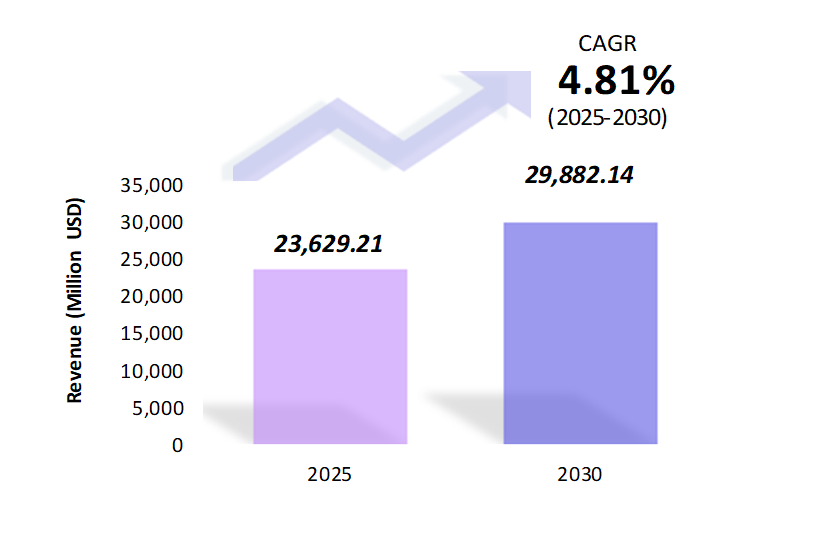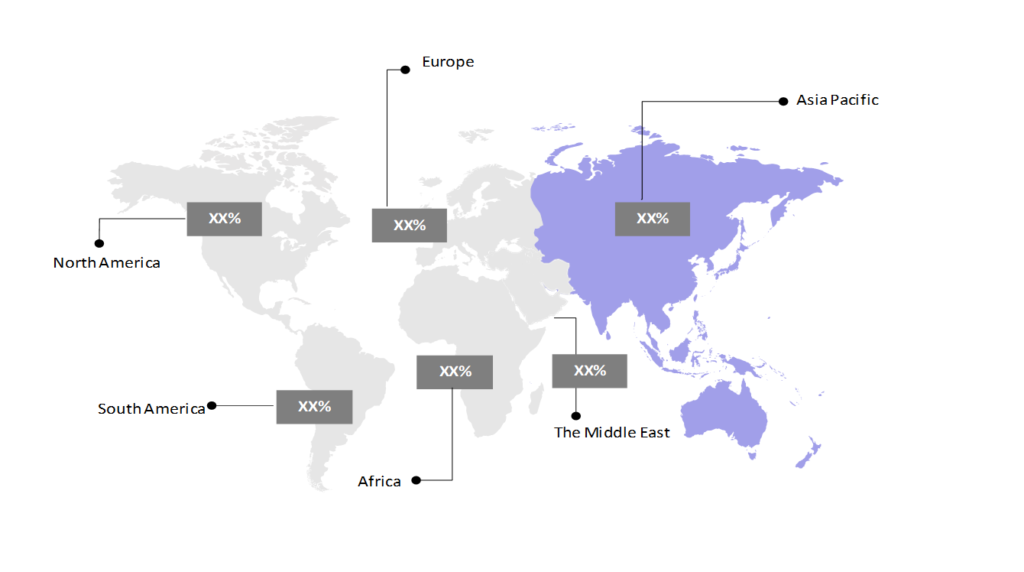Acrylic Resins Market Analysis: Growth, Size, Share & Future Trends (2024-2029)
The market report offers a detailed analysis segmented by Product (Acrylates, Methacrylate, Hybrid); by Application (Paints & Coatings, Buildings & Constructions, Adhesives & Sealants, Plastics, Textiles & Fibers, Papers & Paperboards, Others); by Geography (North America, South America, Asia Pacific, Europe, The Middle East, Africa).
Outlook

- The acrylic resins market is estimated to be at USD 23,629.21 Mn in 2025 and is anticipated to reach USD 29,882.14 Mn in 2030.
- The acrylic resins market is registering a CAGR of 4.81% during the forecast period 2025-2030.
- The acrylic resins market is experiencing steady growth, driven by demand across industries like construction, automotive, packaging, and electronics. Known for their durability, clarity, and versatility, acrylic resins are popular in applications ranging from coatings to adhesives. Growing environmental awareness is shifting the market towards bio-based and low-volatile organic compounds (low-VOC) acrylic options. However, challenges like fluctuating raw material costs and regulatory pressures impact market dynamics, which require manufacturers to innovate continuously.
Request a free sample.
Ecosystem

- The participants in the global acrylic resins industry are always developing their strategies to preserve a competitive advantage.
- Competition is heavily driven by innovation, with companies investing in the development of advanced acrylic resins that meet evolving consumer and regulatory demands.
- Several important entities in the acrylic resins market include Dow Chemical Co.; BASF SE; Arkema Group; Mitsubishi Chemical Group Corp.; Nippon Shokubai Co., Ltd.; and others.
Ask for customization.
Findings
| Attributes | Values |
|---|---|
| Historical Period | 2019-2023 |
| Base Year | 2024 |
| Forecast Period | 2025-2030 |
| Market Size (2025) | USD 23,629.21 Mn |
| Market Size (2030) | USD 29,882.14 Mn |
| Growth Rate | 4.81% CAGR from 2025 to 2030 |
| Key Segments | Product (Acrylates, Methacrylate, Hybrid); Application (Paints & Coatings, Buildings & Constructions, Adhesives & Sealants, Plastics, Textiles & Fibers, Papers & Paperboards, Others); Geography (North America, South America, Asia Pacific, Europe, The Middle East, Africa) |
| Key Vendors | The Dow Chemical Co.; BASF SE; Arkema Group; Mitsubishi Chemical Group Corp.; Nippon Shokubai Co., Ltd. |
| Key Countries | The US; Canada; Mexico; Brazil; Argentina; Colombia; Chile; China; India; Indonesia; Japan; The UK; Germany; Italy; Poland; Turkey; UAE; Saudi Arabia; Egypt; South Africa |
| Largest Market | Asia Pacific |
Get a free quote.
Trends
- Development of Bio-Based Acrylic Resins: Manufacturers are increasingly focusing on bio-based acrylic resins to address environmental concerns and reduce reliance on petroleum-based products. These resins are derived from renewable resources like corn, sugarcane, and soybean oil, which help to lower greenhouse gas emissions and reduce carbon footprints. For instance, Mitsubishi Chemical has created bio-acrylic resins for environmentally friendly coatings, which are now used in consumer goods packaging.
- 3D Printing Applications: High-performance acrylic resins are tailored for 3D printing, which enables rapid prototyping and high-precision parts production. Formlabs has introduced clear acrylic resins compatible with 3D printing, ideal for prototyping in industries like eyewear, where transparency and durability are essential.
- Use of Low-VOC and Odor-Free Resins for Interior Paints: Innovations include low-VOC (volatile organic compounds) and odor-free acrylic resins for eco-friendly interior paints, which reduce health risks for indoor applications. Asian Paints uses advanced acrylic resins in its low-odor paints, catering to health-conscious consumers and urban environments sensitive to pollution.
Speak to analyst.
Catalysts
- Rising Construction Activities and Infrastructure Development: The expansion of construction and infrastructure projects, especially in developing countries, is boosting demand for acrylic-based paints, coatings, and adhesives. These resins are valued for their durability, weather resistance, and application versatility in both residential and commercial buildings.
- Growth in Automotive and Transportation Sectors: The automotive industry’s focus on long-lasting, high-gloss finishes, and scratch-resistant coatings is spurring demand for high-performance acrylic resins. This aligns with consumer expectations for durable, low-maintenance vehicle surfaces and contributes to the increasing use of acrylic resins in automotive paints and coatings. BASF’s Glasurit and R-M acrylic-based automotive coatings are increasingly adopted by luxury car manufacturers like BMW and Mercedes-Benz.
- Increasing Popularity of Water-Based Resins: There’s a shift toward water-based acrylic resins due to rising environmental concerns and stringent regulatory policies against solvent-based products. Water-based resins, known for their low toxicity and improved environmental profile, are becoming essential in coatings, adhesives, and paints, especially in eco-conscious markets like Europe and North America.
Inquire before buying.
Restraints
- Rising Raw Material Costs: Acrylic resins rely on petrochemical derivatives like acrylonitrile and acrylic acid, which are subject to price volatility due to fluctuations in crude oil prices. These rising raw material costs can affect profitability for manufacturers and may lead to higher prices for end-users, impacting demand in cost-sensitive markets.
- Stringent Environmental Regulations: The production and disposal of certain types of acrylic resins, especially solvent-based resins, pose environmental concerns due to VOC emissions. Regulatory bodies in regions like the EU and North America are implementing stricter environmental standards, which increase compliance costs for manufacturers and drive a shift to alternative, often more expensive, eco-friendly materials.
- Technological Limitations in Emerging Applications: While acrylic resins have diverse applications, they may not always meet the advanced requirements of emerging fields like medical devices and certain high-temperature industrial applications. These limitations can hinder their adoption in advanced fields, where materials with specific mechanical or chemical resistance properties are essential.
Personalize this research.
Hotspot

Explore purchase options.
Table of Contents
| 1. Introduction 1.1. Research Methodology 1.2. Scope of the Study 2. Market Overview / Executive Summary 2.1. Global Acrylic Resins Market (2019 – 2023) 2.2. Global Acrylic Resins Market (2024 – 2030) 3. Market Segmentation 3.1. Global Acrylic Resins Market by Product 3.1.1. Acrylates 3.1.2. Methacrylate 3.1.3. Hybrid 3.2. Global Acrylic Resins Market by Application 3.2.1. Paints & Coatings 3.2.2. Building & Constructions 3.2.3. Adhesives & Sealants 3.2.4. Plastics 3.2.5. Textiles & Fibers 3.2.6. Papers & Paperboards 3.2.7. Others 4. Regional Segmentation 4.1. North America 4.1.1. The US 4.1.2. Canada 4.1.3. Mexico 4.2. South America 4.2.1. Brazil 4.2.2. Argentina 4.2.3. Colombia 4.2.4. Chile 4.2.5. Rest of South America 4.3. Asia Pacific 4.3.1. China 4.3.2. India 4.3.3. Japan 4.3.4. Indonesia 4.3.5. Rest of Asia Pacific 4.4. Europe 4.4.1. The UK 4.4.2. Germany 4.4.3. Italy 4.4.4. Poland 4.4.5. Rest of Europe 4.5. The Middle East 4.5.1. Turkey 4.5.2. UAE 4.5.3. Saudi Arabia 4.5.4. Rest of the Middle East 4.6. Africa 4.6.1. Egypt 4.6.2. South Africa 4.6.3. Rest of Africa 5. Value Chain Analysis of the Global Acrylic Resins Market 6. Porter Five Forces Analysis 6.1. Threats of New Entrants 6.2. Threats of Substitutes 6.3. Bargaining Power of Buyers 6.4. Bargaining Power of Suppliers 6.5. Competition in the Industry 7. Trends, Drivers and Challenges Analysis 7.1. Market Trends 7.1.1. Market Trend 1 7.1.2. Market Trend 2 7.1.3. Market Trend 3 7.2. Market Drivers 7.2.1. Market Driver 1 7.2.2. Market Driver 2 7.2.3. Market Driver 3 7.3. Market Challenges 7.3.1. Market Challenge 1 7.3.2. Market Challenge 2 7.3.3. Market Challenge 3 8. Opportunities Analysis 8.1. Market Opportunity 1 8.2. Market Opportunity 2 8.3. Market Opportunity 3 9. Competitive Landscape 9.1. The Dow Chemical Co. 9.2. BASF SE 9.3. Arkema Group 9.4. Mitsubishi Chemical Group Corp. 9.5. Nippon Shokubai Co., Ltd. 9.6. Company 6 9.7. Company 7 9.8. Company 8 9.9. Company 9 9.10. Company 10 |
Know the research methodology.
Acrylic Resins Market – FAQs
1. What is the current size of the acrylic resins market?
Ans. In 2025, the acrylic resins market size is USD 23,629.21 Mn.
2. Who are the major vendors in the acrylic resins market?
Ans. The major vendors in the acrylic resins market are Dow Chemical Co.; BASF SE; Arkema Group; Mitsubishi Chemical Group Corp.; Nippon Shokubai Co., Ltd.
3. Which segments are covered under the acrylic resins market segments analysis?
Ans. The acrylic resins market report offers in-depth insights into Product, Application, and Geography.
